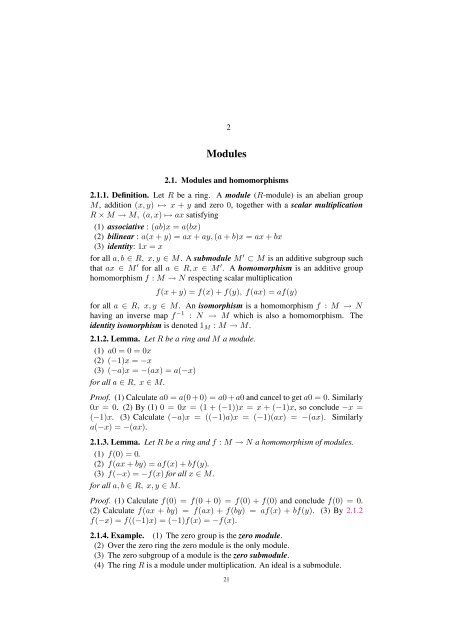Commutative algebra - Department of Mathematical Sciences - old ...
Commutative algebra - Department of Mathematical Sciences - old ...
Commutative algebra - Department of Mathematical Sciences - old ...
You also want an ePaper? Increase the reach of your titles
YUMPU automatically turns print PDFs into web optimized ePapers that Google loves.
2<br />
Modules<br />
2.1. Modules and homomorphisms<br />
2.1.1. Definition. Let R be a ring. A module (R-module) is an abelian group<br />
M, addition (x, y) ↦→ x + y and zero 0, together with a scalar multiplication<br />
R × M → M, (a, x) ↦→ ax satisfying<br />
(1) associative : (ab)x = a(bx)<br />
(2) bilinear : a(x + y) = ax + ay, (a + b)x = ax + bx<br />
(3) identity: 1x = x<br />
for all a, b ∈ R, x, y ∈ M. A submodule M ′ ⊂ M is an additive subgroup such<br />
that ax ∈ M ′ for all a ∈ R, x ∈ M ′ . A homomorphism is an additive group<br />
homomorphism f : M → N respecting scalar multiplication<br />
f(x + y) = f(x) + f(y), f(ax) = af(y)<br />
for all a ∈ R, x, y ∈ M. An isomorphism is a homomorphism f : M → N<br />
having an inverse map f −1 : N → M which is also a homomorphism. The<br />
identity isomorphism is denoted 1M : M → M.<br />
2.1.2. Lemma. Let R be a ring and M a module.<br />
(1) a0 = 0 = 0x<br />
(2) (−1)x = −x<br />
(3) (−a)x = −(ax) = a(−x)<br />
for all a ∈ R, x ∈ M.<br />
Pro<strong>of</strong>. (1) Calculate a0 = a(0 + 0) = a0 + a0 and cancel to get a0 = 0. Similarly<br />
0x = 0. (2) By (1) 0 = 0x = (1 + (−1))x = x + (−1)x, so conclude −x =<br />
(−1)x. (3) Calculate (−a)x = ((−1)a)x = (−1)(ax) = −(ax). Similarly<br />
a(−x) = −(ax).<br />
2.1.3. Lemma. Let R be a ring and f : M → N a homomorphism <strong>of</strong> modules.<br />
(1) f(0) = 0.<br />
(2) f(ax + by) = af(x) + bf(y).<br />
(3) f(−x) = −f(x) for all x ∈ M.<br />
for all a, b ∈ R, x, y ∈ M.<br />
Pro<strong>of</strong>. (1) Calculate f(0) = f(0 + 0) = f(0) + f(0) and conclude f(0) = 0.<br />
(2) Calculate f(ax + by) = f(ax) + f(by) = af(x) + bf(y). (3) By 2.1.2<br />
f(−x) = f((−1)x) = (−1)f(x) = −f(x).<br />
2.1.4. Example. (1) The zero group is the zero module.<br />
(2) Over the zero ring the zero module is the only module.<br />
(3) The zero subgroup <strong>of</strong> a module is the zero submodule.<br />
(4) The ring R is a module under multiplication. An ideal is a submodule.<br />
21
















